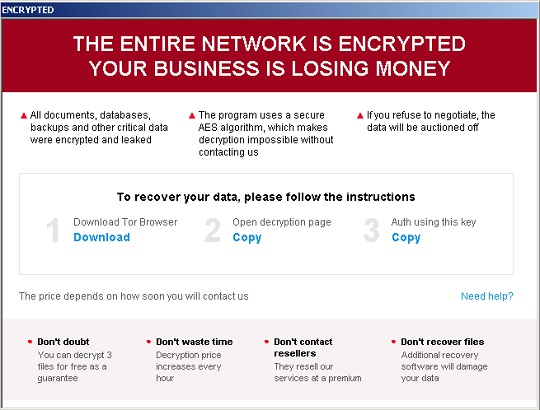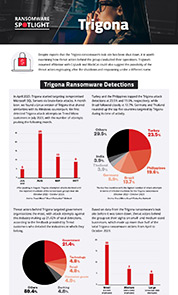Ransom.Win32.TRIGONA.THABOBC
Ransom.Trigona.S29786555(QUICKHEAL)
Windows


Threat Type: Ransomware
Destructiveness: No
Encrypted: No
In the wild: Yes
OVERVIEW
This Ransomware arrives on a system as a file dropped by other malware or as a file downloaded unknowingly by users when visiting malicious sites.
It drops files as ransom note.
TECHNICAL DETAILS
Arrival Details
This Ransomware arrives on a system as a file dropped by other malware or as a file downloaded unknowingly by users when visiting malicious sites.
Installation
This Ransomware drops the following files:
- %User Temp%\how_to_decrypt.hta
- {Encrypted Directory}\how_to_decrypt.hta
- {Drive Letter}\how_to_decrypt.hta
(Note: %User Temp% is the current user's Temp folder, which is usually C:\Documents and Settings\{user name}\Local Settings\Temp on Windows 2000(32-bit), XP, and Server 2003(32-bit), or C:\Users\{user name}\AppData\Local\Temp on Windows Vista, 7, 8, 8.1, 2008(64-bit), 2012(64-bit) and 10(64-bit).)
It adds the following processes:
- "%System%\mshta.exe" "%User Temp%\how_to_decrypt.hta"
(Note: %User Temp% is the current user's Temp folder, which is usually C:\Documents and Settings\{user name}\Local Settings\Temp on Windows 2000(32-bit), XP, and Server 2003(32-bit), or C:\Users\{user name}\AppData\Local\Temp on Windows Vista, 7, 8, 8.1, 2008(64-bit), 2012(64-bit) and 10(64-bit).)
It adds the following mutexes to ensure that only one of its copies runs at any one time:
- {Generated ID} → Derived from computer name
Autostart Technique
This Ransomware adds the following registry entries to enable its automatic execution at every system startup:
HKEY_CURRENT_USER\Software\Microsoft\
Windows\CurrentVersion\Run
{Generated ID 1} = {Malware File Path}\{Malware File Name}.{Malware File Extension}
HKEY_CURRENT_USER\Software\Microsoft\
Windows\CurrentVersion\Run
{Generated ID 2} = %User Temp%\how_to_decrypt.hta
Information Theft
This Ransomware accepts the following parameters:
- /r → Encrypt files in random order
- /full → Encrypt the whole contents of a file
- /!autorun → Do not create autorun registry entry
- /is_testing → For testing purposes, used with /test_cid and /test_vid
- /test_cid → Use the specified value instead of generating a computer ID
- /test_vid → Use the specified value instead of the hardcoded victim ID (VID) from the configuration
- /p → Specify path to encrypt
- /path → Specify path to encrypt
- /!local → Do not encrypt local files
- /!lan → Do not encrypt network shares
- /shdwn → Turn off the machine after encryption using the parameter -f -s -t 00
- /autorun_only → Create Autorun registry entry
It gathers the following data:
- Computer Name
- User Name
- OS Version
- Available disk drives
- Free disk space on all available drives
- Keyboard Layout
- System Locale
Ransomware Routine
This Ransomware avoids encrypting files with the following strings in their file name:
- how_to_decrypt.hta
It avoids encrypting files with the following strings in their file path:
- windows
- system32
It renames encrypted files using the following names:
- available_for_trial.{Random}.{Random}._locked
- {Random}.{Random}._locked
It drops the following file(s) as ransom note:
- how_to_decrypt.hta

- %User Temp%\how_to_decrypt.hta
- {Drive Letter}\how_to_decrypt.hta
SOLUTION
Step 1
Trend Micro Predictive Machine Learning detects and blocks malware at the first sign of its existence, before it executes on your system. When enabled, your Trend Micro product detects this malware under the following machine learning name:
- Troj.Win32.TRX.XXPE50FFF069
Step 2
Before doing any scans, Windows 7, Windows 8, Windows 8.1, and Windows 10 users must disable System Restore to allow full scanning of their computers.
Step 3
Note that not all files, folders, and registry keys and entries are installed on your computer during this malware's/spyware's/grayware's execution. This may be due to incomplete installation or other operating system conditions. If you do not find the same files/folders/registry information, please proceed to the next step.
Step 4
Restart in Safe Mode
Step 5
Delete this registry value
Important: Editing the Windows Registry incorrectly can lead to irreversible system malfunction. Please do this step only if you know how or you can ask assistance from your system administrator. Else, check this Microsoft article first before modifying your computer's registry.
- In HKEY_CURRENT_USER\Software\Microsoft\Windows\CurrentVersion\Run
- {Generated ID 1} = {Malware File Path}\{Malware File Name}.{Malware File Extension}
- {Generated ID 1} = {Malware File Path}\{Malware File Name}.{Malware File Extension}
- In HKEY_CURRENT_USER\Software\Microsoft\Windows\CurrentVersion\Run
- {Generated ID 2} = %User Temp%\how_to_decrypt.hta
- {Generated ID 2} = %User Temp%\how_to_decrypt.hta
Step 6
Search and delete this file
- %User Temp%\how_to_decrypt.hta
- {Encrypted Directory}\how_to_decrypt.hta
- {Drive Letter}\how_to_decrypt.hta
Step 7
Restart in normal mode and scan your computer with your Trend Micro product for files detected as Ransom.Win32.TRIGONA.THABOBC. If the detected files have already been cleaned, deleted, or quarantined by your Trend Micro product, no further step is required. You may opt to simply delete the quarantined files. Please check this Knowledge Base page for more information.
Step 8
Restore encrypted files from backup.
Did this description help? Tell us how we did.


